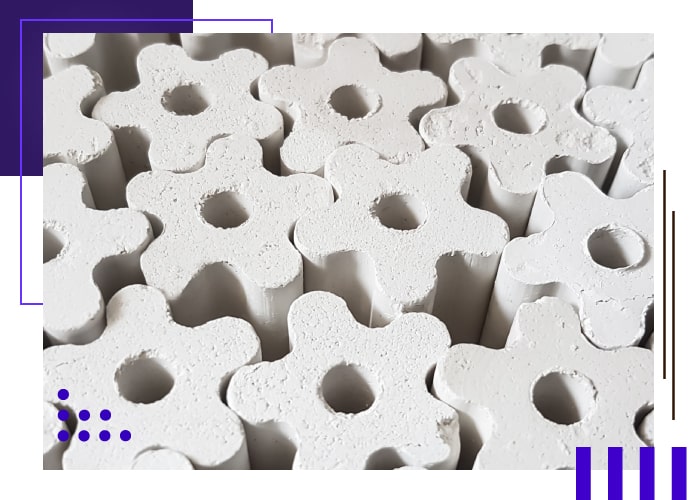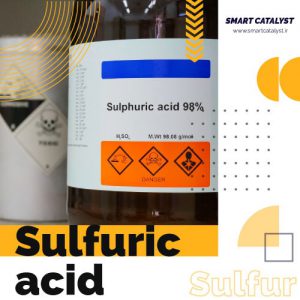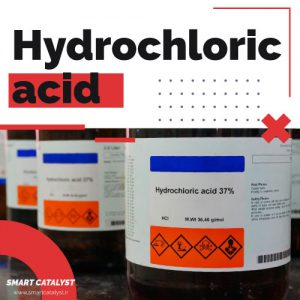Zinc oxide is used as a sulfur adsorbent in the oil, gas, petrochemical and ammonia industries in iran. The amount of using zinc oxide adsorbent in domestic petrochemical complexes has been estimated to be 300 tons per year. Besides, sulfur elimination is a vital issue for maintaining the health of the environment. Also, after performing experiments and testing various chemical methods, it has been proved that oxide absorbent is the most effective and most economic material for eliminating sulfur and also H2S. Therefore, Smart Catalyst Company after successful production of styrene monomer catalyst, initiate production of ZnO adsorbent order to answer the domestic market and reducing import needs.
Form Ring and Star Ring grades have 70% less pressure drop and the maximum absorption capacity is achieved. But after three months due to the pressure drop, the form Pellet grade should be drained, even if 20-30% of absorption capacity has not been achieved. The SmartZn series of adsorbents and catalysts are used for the purification of almost all hydrocarbon feedstocks. This purification is typically a combination of a reaction using a pretreatment catalyst. Main reaction of the desulfurization process is as follows:
H2S + ZnO → ZnS + H2O
The following table gives a general overview of the different families of SmartZn materials. It is necessary to remove sulfur to below 10 ppb H2S.
| Physical Properties | |||
| Code | SmartZn110 | SmartZn210 | SmartZn220 |
| Form | Pellet | ||
| Size, mm | 6 × 6-10 | 4.5 × 5-10 | 6× 6-10 |
| Bulk Density, kg/l | 1.1 – 1.3 | 1.1 – 1.3 | 1.1 – 1.3 |
| Min. Average Crush Strength, kgf | ≥ 8 | ≥ 50 | ≥ 50 |
| Operating Temp, ◦C | 180-420 | 250-420 | 250-420 |
| Chemical Analysis (Nominal, wt%) | |||
| ZnO | 90 ± 3.0 | > 90 | > 95 |
| CuO | 2 ± 2.0 | – | – |
| Al2O3 | Balance | Balance | Balance |
| LOI at 540 ◦C | ≤ 10 | ≤ 5 | ≤ 2 |
| Grade | Composition | Shape | Operating Temp (◦C) | Application |
| SmartZn221 | ZnO | Ring 10*6 mm | 250-420 | Removal of H2S, COS, Cl, F, Dust |
| SmartZn330 | ZnO Al2O3 |
Pellet 10*6 mm | 250-420 | Removal of H2S, COS, Cl, F, Dust |
| SmartZn331 | ZnO Al2O3 |
Ring 10*6 mm | 250-420 | Removal of H2S, COS, Cl, F, Dust |
| SmartZn340 | ZnO Al2O3 |
Star Ring 10*4 mm | 250-420 | Removal of H2S, COS, Cl, F, Dust |
Properties of Zinc oxide adsorbent produced by Smart Catalyst Company
- Non-toxic absorbent
- Minimum pressure drop
- No powdering
- High strength
- Very high absorbency
- surface and high porosity
- Remove discharge and constant charge in steel processes
- with recovery capability

Services of Smart Catalyst Company in the domain of producing zinc oxide adsorbent
It is noteworthy that zinc oxide adsorbent , just like other products of Smart Catalyst Company, has the necessary technical and quality standards, and the following items have been thoroughly and completely scrutinized for its production:
- Operational and physical conditions
- Measuring and examining the optimal temperature and pressure
- The amount of H2S concentration in the input feed of the process
- Measuring the particles of ZnO adsorbent
- Measuring the substrate of catalysts which are used during the process
Smart Catalyst Company has prospered to demonstrate a really effectual green catalytic method with ZnO nanoparticles. ZnO catalytic nanoparticles are easily distinguishable with XRD technique. This approach presents several advantages, such as:
Avoiding harmful organic solvents, high performance, short reaction time, ease of separation process and recyclability of the catalyst.



